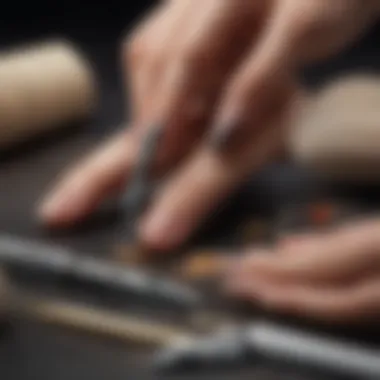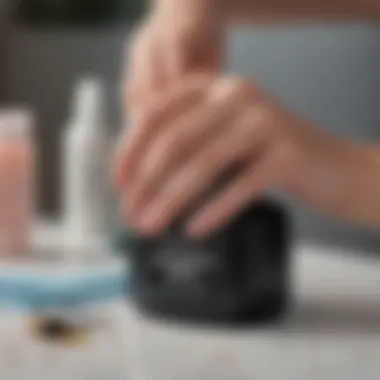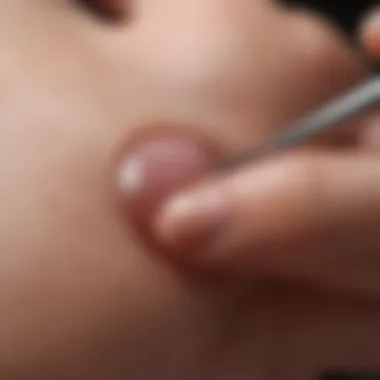Comprehensive Guide to Removing Dip Nails Safely


Intro
Dip nails have become a popular choice for many women seeking a durable and beautiful manicure. Although they offer long-lasting results, removing dip nails can pose challenges if not done correctly. Understanding the proper methods and precautions is essential. In this article, we will explore the crucial aspects of dip nail removal, discussing various methods, the necessary tools, and offering aftercare recommendations.
Trend Report
Latest Nail Trends
In recent years, nail care has evolved into a fashionable aspect of personal grooming. Many women now actively look for safe techniques that do not damage their natural nails. Trends show an inclination toward versatile designs, balance between classic and bold feels. There is an increased focus on using quality products that promise effective results without sacrificing nail health.
Beauty Trends
Not only is nail care important, but also the associated beauty practices have transformed. Regular pampering and attention to nails are reflective of self-care culture. Many women prioritize well-being, which includes indulging in beauty treatments like manicure combined with dips—because it's essential to look and feel good.
Seasonal Trends
Different seasons bring influences to nail designs too. In winter, for example, darker and rich colors are sought frequently, while light pastel tones are seen in spring. These changing demands guide nail technicians towards innovative approaches in products and techniques. The continual update in nails artistry leads directly to how women choose to remove dip nails in the comfort of their homes or salons.
Tools Required
A successful dip nail removal starts with preparing properly. Below is are essential tools you'll need:
- Acetone-based nail polish remover
- Cotton balls or pads
- Aluminum foil
- Nail clipper and file
- Buffer
- Cuticle oil or moisturizer
Having these on hand not only streamlines the process but también reduces potential frustration or nail damage.
Step-by-Step Procedure
- Start by cliping nails to decrease the overall length, making removal easier.
- Use a file to fo away the top layer of the dip polish. Be cautious not to file too deep — you don’t want to damage the surface of your nails.
- Soak the cotton balls in acetone and place one over each nail.
- Wrap the aluminum foil around your fingertips to hold the soaked cotton in place. Leave it on for about 10-15 minutes.
- After time has passed, check one nail to see if the polish has softened.
- Use an orange stick or cuticle pusher to gently scrape off the used dip nail powder.
- Lastly, wash your hands well and apply cuticle oil to rehydrate your nail beds.
Aftercare Recommendations
Removing dip nails can leave them susceptible to fine damage. To maintain their health, consider these recommendations:
- Moisturize your nails and cuticles with good oils.
- Avoid harsh nail products instating to polish for a few days post-removal.
- Allow your nails to breathe without coverings.
- If necessary, treat your nails to nourishing treatments or manicures that do not include heavy product use for some time.
Here, understanding the removal techniques connects your desire to maintain beautiful nails.
By following the above strategies provided, readers will find a comprehensive fit, helping understanding their needs and efforts with dip nails. Explore each aspect of dip nail care, and ensure beauty does not come at a price of safety.
Understanding Dip Nails
Dip nails have become increasingly popular among those who desire a long-lasting manicure. Understanding the unique characteristics and potential implications of dip nails is critical for anyone interested in maintaining the health and aesthetics of their nails. This section will cover what dip nails are, their benefits, and common concerns surrounding their use.
What are Dip Nails?
Dip nails are a particular nail enhancement technique that uses a powder and a bonding solution to create a durable and appealing manicure. Unlike traditional acrylic or gel nails, dip nails do not require the use of a UV light for curing. The process involves applying a bonding agent to the nails, which is then dipped in colored powder multiple times until the desired thickness and hue are achieved. This allows for versatile designs and colors without the use of heat or light.
It appeals to individuals seeking a budget-friendly service with a long-lasting finish. Due to their construction methods, they differ from other nail techniques and deserve careful attention when considering removal.


Benefits of Dip Nails
The popularity of dip nails comes from a combination of practical and aesthetic benefits.
- Durability: Dip nails are widely regarded for their strength. They can last for several weeks, making them appropriate for busy lifestyles.
- Speedy Application: The procedure for dip nails typically takes less time than acrylic nails. One does not have to endure additional curing times with UV light.
- Variety of Colors: The range of available dip powder colors is vast. This means that individuals can express their style without compromise.
- Minimal Odor: Many find the scent produced during the application process less overwhelming than typical acrylics, creating a more pleasant experience.
In essence, these advantages make dip nails an enticing choice for those who often seek manicures that can endure through daily tasks.
Common Concerns with Dip Nails
While dip nails offer numerous advantages, there are various concerns that potential users should address.
- Potential Damage: Some studies indicate that improper application and removal of dip nails can lead to weakened natural nails. Users must take care during both the essence of getting them and how they are removed.
- Skin Sensitivity: The bonding agents and dip powders can cause irritation for some individuals, particularly those with sensitivities or nail allergies. Before proceeding, it can be wise to consult with a professional.
- Hygiene Concerns: Because dip nails often involve shared products and supplies, ensuring sanitation is critical. One should choose a reputable salon that prioritizes cleanliness to avoid health risks.
- Time and Cost: While effective in the short run, issues can arise with needing frequent fills and possible consultation with a professional for damage care.
Ultimately, understanding the emergent concerns guarantees better decision-making regarding beauty practices connected to dip nails.
Preparing for Removal
Removal of dip nails is a nuanced procedure that requires thoughtful preparation. Skipping this crucial step can lead to unwanted damage and complications. Proper preparation sets the stage for an effective removal process, ensuring the health of your natural nails is preserved while you achieve your desired look.
Gathering the Necessary Tools
To execute a safe and effective removal, the right tools are paramount. Using high-quality products enhances the process while minimizing the risk. Below are essential tools, each serving a unique role in an efficient dip nail removal.
Acetone
Acetone is a solvent that effectively dissolves the dip nail material. It’s the most popular and reliable option for this purpose. One key characteristic of acetone is its ability to break down the layered product quickly. The use of acetone helps to accelerate the entire removal process, which can be a time saver.
However, the downside of acetone is its harsh nature. Frequent use can result in dried-out nails and cuticles, so it’s advisable to use this product judiciously.
Nail File
A nail file plays a crucial role in preparation before using acetone. By gently decreasing the top layer of dip nails, the file makes it easier for acetone to penetrate through the polish. A key characteristic of nail files is their varying grits. A coarser grit helps to lift the top layer efficiently, while finer grits can be used later to smooth out the edge of the nail. However, it is important to use the nail file with care to avoid damaging the natural nail underneath.
Cotton Balls
Cotton balls are important for application. They effectively hold the acetone while also providing gentleness against the nails. Their absorption capacity ensures that the right amount of acetone is applied without excessive wastage, making them both economical and practical. Another benefit is they fit well onto fingertips, making it easy to wrap around the nail. The only potential downside is that they can break apart if too much force is applied, leading to bits of cotton litter in the workspace.
Nail Buffer
The nail buffer is vital for smoothing the surface of the nail post-removal. One notable feature of a nail buffer is that it can rejuvenate dull nails that might appear after dip removal. This tool gradually removes imperfections and can stimulate blood flow in the natural nails. Care must be taken when using the buffer to avoid over-buffing, which can cause thinning.
Cuticle Oil
After the removal process, cuticle oil is necessary for hydration and nourishment. It brings back moisture to the nail and surrounding skin that may have been stripped away by acetone. Cuticle oil is particularly beneficial for maintaining healthy nails in the long term. The unique feature of cuticle oil is its ability to deeply penetrate dry surfaces, aiding in repairing the effects caused by harsh removals. It has minimal downsides but can be somewhat thick to use if applied too liberally.
Setting Up Your Workspace
The workspace requires a flat and well-lit area to visualize better what you are doing during removal. Good lighting is essential for identifying areas where chips or stubborn remains linger. Keep the aforementioned tools clearly situated for easy accessibility during the process. Ensure there is a clean towel nearby to manage spills as acetone may have adverse effects on various surfaces.
Assessing Nail Health
Before removing dip nails, assessing the health of your natural nails is an important step. Look for signs including brittleness or signs of infection. If your nails exhibit these signs, consider consulting a professional for tailored advice. Understanding your nail condition can dictate the best approach for applying and removing products in the future.


Step-by-Step Removal Process
The process of removing dip nails requires precision and care. This section highlights the importance of following a step-by-step method to ensure effectiveness and safety. Proper removal significantly reduces the risk of damage to natural nails, allowing for a smoother transition to the next application or promoting healthy nail growth in general. By following the outlined steps, one can avoid potential pitfalls associated with incorrect techniques, ensuring a desirable outcome. Furthermore, knowledge of this process equips individuals with the confidence to undertake at-home nail care, ensuring that results meet personal satisfaction.
Filing the Top Layer
Filing the top layer of dip nails is an essential first step in the removal process. It reduces the thickness of the dip layer, allowing acetone to penetrate more effectively and dissolve the product faster. A medium-grit nail file is ideal for this task. Use gentle, even strokes to avoid damaging the underlying nail bed.
Ensure even removal across the entire nail surface rather than focusing on just one area. This diligence prevents unnecessary strain on any single spot. Check the health of your nails during this stage. If the natural nail appears weak or damaged, reconsider the method you are using for removal and be cautious going forward.
Applying Acetone
Once the top layer is filed down, it is time to apply acetone. This step involves saturating the cotton balls with 100% acetone, as higher concentrations tend to work more efficiently at breaking down the dip nails. Carefully place the soaked cotton onto each nail, ensuring complete coverage.
To facilitate this process, consider using acetone that is not mixed with additional ingredients, which can offer only temporary relief of adhesion without effective removal. Make certain your workspace is well-ventilated and avoid skin contact with acetone, as it can lead to irritation.
Wrapping Method
The wrapping method is considered one of the most effective approaches to removing dip nails. After applying acetone, use aluminum foil squares to cover each finger, securing cotton balls in place. This setup creates a closed environment, maintaining warmth, which increases the effectiveness of the acetone.
Leave the wraps on for 10 to 15 minutes, or as recommended based on nail health. Feel free to check after 10 minutes to assess how quickly the dip is breaking down. If necessary, you can keep the wraps on for a little longer. Remove gently and avoid using excessive force.
Soaking Method
Alternatively, the soaking method provides a different avenue for acetone penetration. For this approach, pour acetone into a bowl and immerse your nails for approximately 15 to 20 minutes. Ensure ample acetone is available to cover the nails completely.
Like the wrapping method, this technique can also lead to effective cleanup of the dip nails. Monitor the condition of the nails as you soak. Remove cancelled edges using an orange stick or a gentle scraper to aid the dissolution of built material but understand that minimal pressure will enhance outcomes.
Gently Removing the Dip
Once either method is complete and the dip has sufficiently softened, carefully remove what remains on your fingernails. Use a gentle pressure, as pushing too hard or scrapping aggressively may strip away layers of the natural nails, leading to any unwanted damage.
If the dip does not come off easily, reapply acetone and allow more time for it to work. Patience is key in this process. Observe the remaining product carefully and attend meticulously to any area that remains untouched while focusing on a safe, pressure-free removal seeking comfort and health for the nail surface.
Taking the time to follow these processes not only safeguards your nails but brings about an efficient overall removal experience, yielding strong and healthy nails in the future.
Aftercare for Your Nails
After removing dip nails, your nail health is paramount. Proper aftercare ensures that your nails recover from the effects of chemicals and physical removal methods. Neglecting this aspect can result in thinning, brittleness, or other issues that would affect their appearance and strength. It is essential to understand what steps to take afterward to promote healing and maintain the look of your nails.
Moisturizing and Nourishing
Nails lose moisture during the dip nail removal process. Consequently, it becomes vital to restore hydration. Moisturizing your nails and surrounding skin can counteract the potential dryness caused by acetone and filing. Use nourishing products like cuticle oil or hand creams that include ingredients like jojoba oil, vitamin E, or shea butter. Not only do these help in hydration, but they also improve flexibility and promote healthy nail growth while nourishing the skin around your nails.
In practical terms, apply cuticle oil directly to your nail beds and gently massages it in to ensure proper absorption. Make this part of your routine, ideally every day for the first week after removal. It supports overall nail health and enhances the shine, thus minimizing any unattractive dullness after dip nails.
Dealing with Damage
Sometimes, nails endure damage even with careful removal techniques. If your nails appear weaker or show signs of peeling, consider methods to strengthen them. One effective choice is using strengthening nail polish or treatments specifically designed to rebuild nail integrity. Look for formulas that contain proteins, calcium, or keratin, as these ingredients fortify your nails.
Additionally, give your nails a break from further beautification. Allow time for recovery, avoiding new layers of polish or further drilling. Corrobate this shedding process by keeping nails short and manageable, preventing splits or tears. Always monitor your nails; if any persistent damage occurs, treatment needs specific attention.


Consulting a Professional
In certain scenarios, self-care measures may not suffice. If multiple signf of damage arise or if infections develop, go to a nail professional or dermatologist for evaluation. Consulting a pro can provide valuable insights tailored to your specific type of nail and personal requirements. They will offer treatments you might not have access to at home, further enhancing recovery.
Living an informed lifestyle includes proactively making decisions. The earlier you seek guidance if issues arise, the better. This intervention might prevent larger complications later on. Remember that investing in your nail and skin health pays off in both the aesthetic under the nails and the confidence you exhibit when showcasing your hands.
Professional vs.
At-Home Removal
Understanding the differences between professional and at-home removal of dip nails is crucial for anyone looking to maintain their nail health and aesthetics. Both methods have unique advantages and potential drawbacks. Professional removal tends to ensure safer processes under the guidance of skilled technicians, while at-home removal saves time and money. However, the decision you make depends on your specific situation, including the condition of your nails and your budget.
When to Choose Professional Services
There are specific instances when opting for a professional service is advisable. If your nails show significant damage or have several layers of dip, a professional can assess the situation and ensure a gentler removal process.
Reasons to seek out a professional include:
- Nail Health: If you have underlying nail health issues, it is wise to consult experts to avoid exacerbating any problems.
- Time Efficiency: Professionals can often remove dip nails more quickly than an individual at home.
- Quality of Tools: Salons have advanced equipment and high-quality products that promote safer removal.
People who are apprehensive about causing self-injury or complicating their nail recovery should also consider professional services as a safer alternative.
Cost Considerations
Financial factors greatly influence whether you choose at-home removal or visit a salon. Professional services can vary widely in cost, often depending on the geographical location and reputation of the salon. While many may find the initial investment higher, it sometimes reflects experience and technique.
On the other hand, consistently purchasing tools or products for at-home removal can become costly over time. Nonetheless, if you plan to maintain your dip nails on a regular basis, investing in proper materials for home care can long-term benefit.
When comparing the two options, here are some points to consider:
- Initial Consultation: Many nail salons offer consultations, some might charge it as part of your service.
- Long-Term Costs: Calculate what regular visits costs for maintenance or removal versus buying the materials for home use.
- Bargain Content: Some salons offer package deals for multiple visits.
In the end, weigh the benefits of professional expertise against the convenience and cost-effectiveness of at-home processes. Each simply has its own merit.
It's vital to carefully consider both the condition of your nails and your budget before deciding between professional and at-home removal.
Final Thoughts on Dip Nail Removal
When it comes to removing dip nails, there are crucial elements to consider for the best outcome. The removal process must be carried out with care to not only protect your nail health but also to ensure that the beauty of your nails can be preserved. As you follow through this guide, the importance of approaching dip nail removal with knowledge cannot be overstated. Missteps in the removal process can lead to damage, making follow-up maintenance vital.
Understanding exactly how to navigate the removal process ensures both safety and effectiveness. This final section encapsulates key points to help you navigate future experiences with dip nails more confidently.
Maintaining Nail Health
Maintaining nail health post-dip nail removal is essential. Nail plates can be fragile after extended use of dip nails. Studies show that improper removal may lead to thin, weak, or even discolored nails. To combat this, it is optimal to focus on restoration and rebuilding.
Consider regularly applying cuticle oil, as it replenishes moisture. Additionally, practices such as applying a strengthening base coat can prevent damage during the subsequent nail application. It's important to allow a break between reapplications to let the nails breathe. Scheduling visits to a manicure professional for even further maintenance can provide personalized insights regarding individual nail needs.
Regular checks for splits and flakes will help identify issues promptly, preventing longer-term challenges. Utilizing a hardening agent can also be beneficial in restoring your nail's natural integrity over time.
Future Nail Care Practices
Future nail care practices post-removal set a strong foundation for all your nail aesthetic endeavors. Fostering an understanding of your nail health begins with maintaining a balanced routine. Include rich moisturizers and nutritional supplements that support healthy nail growth. An adequate diet that incorporates vitamins like Biotin may also benefit overall nail strength inclusively.
Developing habits such as avoiding harsh chemicals, and wearing gloves when engaged in cleaning or gardening will nurture your nail environment.
Listening to your nails means observing how they respond to various products. Testing new techniques and products gently allows time for tuning in to your nails' unique requirements. Remember, each time you remove or apply enhancement, it shapes your nails' future health.



